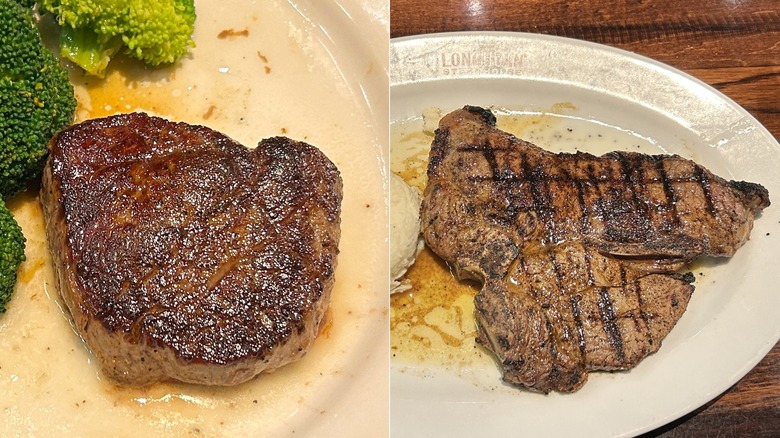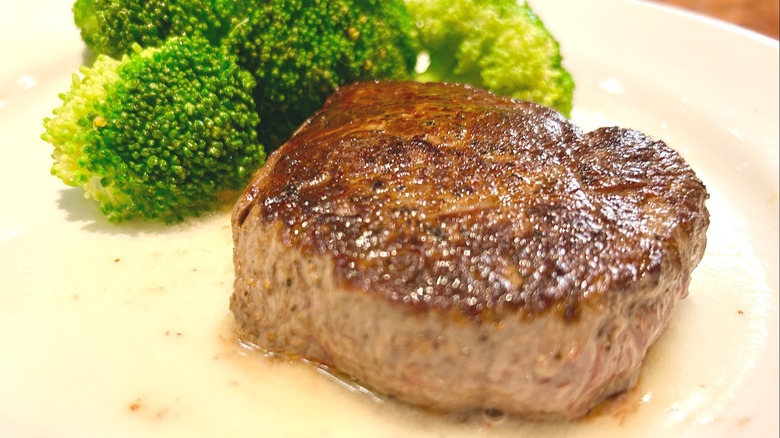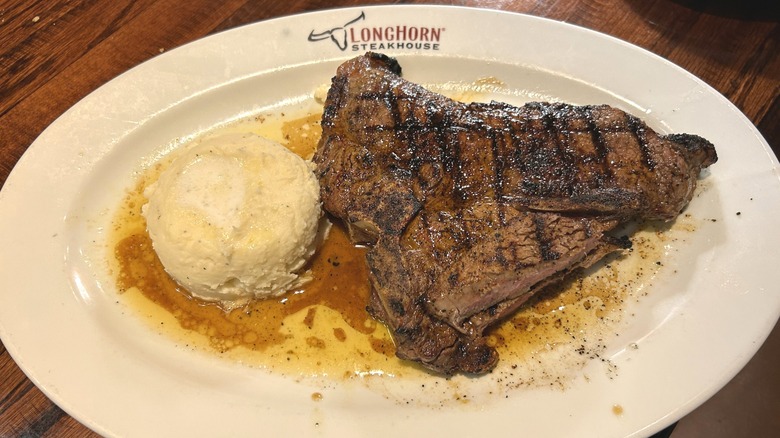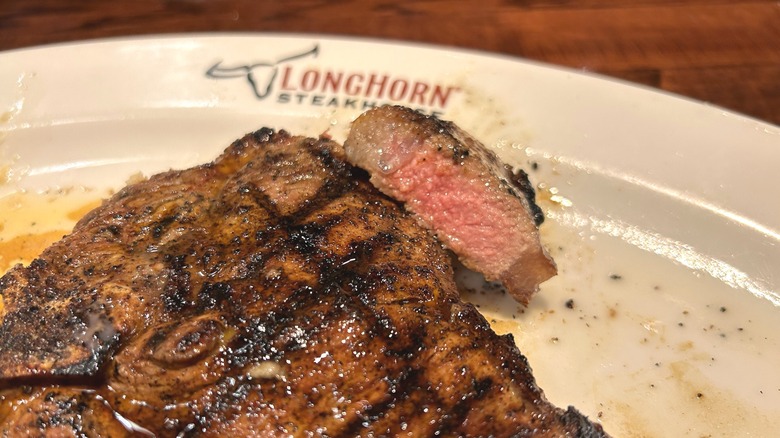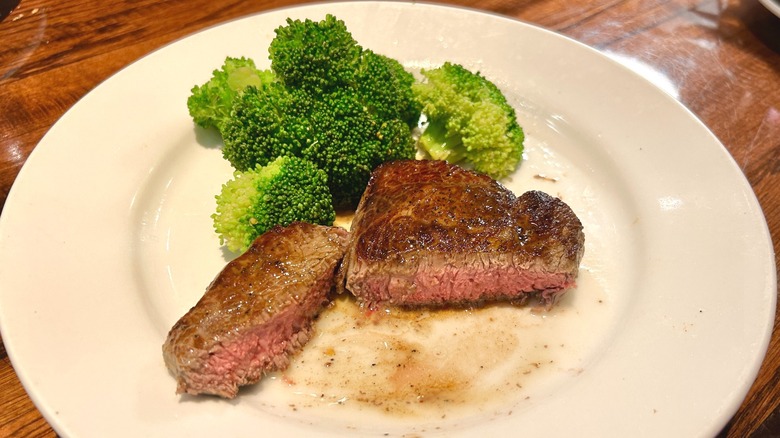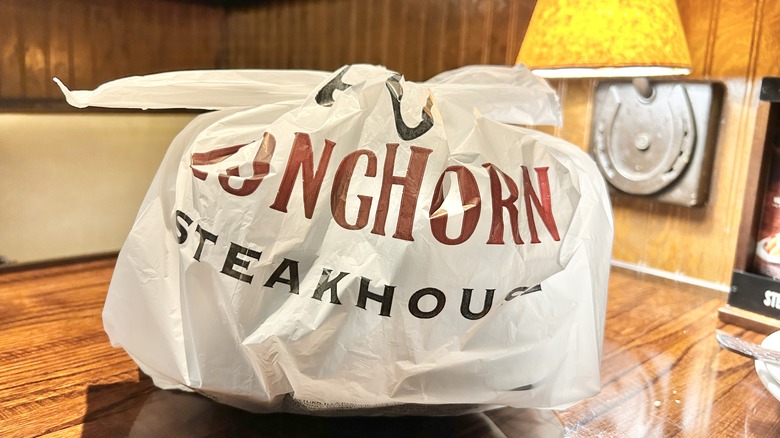The Most Expensive Steak At LongHorn Steakhouse Vs The Cheapest
What's the real difference between the most expensive and cheapest steak at LongHorn Steakhouse? Well, I needed to find out. There is quite a price difference (more than double!) between these two fresh, never frozen options, so it really made me wonder what sets the two cuts apart. Going into this experiment, I thought it might just be a sizing thing, as paying for a humble 6-ounce steak is obviously going to be a lot different than one that is a massive 22 ounces. However, after tasting both, I can definitely say that the price difference and size of these two steaks aren't the only things that set them apart.
I also considered their taste, cut (as in, where they come from on the cow), plating, and presentation, as well as just how full and satisfied eating each one made me feel. You can read more about how I evaluated the steaks at the end of the article. However, for now, just know that I thought there was a clear winner... and it's not what you might think.
What is the cheapest steak at LongHorn SteakHouse?
The cheapest steak option at the restaurant is the Renegade Sirloin, which is 6 ounces in its smallest size. At my location in Houston, it costs $15.79 + tax on the dinner menu, and is just a touch cheaper at lunch. That includes a side and salad, too. It has 320 calories, 15 grams of fat, and 530 grams of sodium.
I asked for the steak to come out medium rare and it was cooked true to form. It was tender and juicy, as well as easy to both cut and chew. The meat was so tender it felt a bit like a butter pat was melting in my mouth. It was a solid-looking steak, in that it didn't have any char marks on it.
The only downsides of the Renegade Sirloin would be its salty rub, which I scraped off with my knife to make the meat a touch more enjoyable, and its small size. While it was the perfect portion for me, those with a larger appetite are likely to find themselves a little hungry at the end of the meal, even if they do load up on the free bread at the table.
What is the most expensive steak at LongHorn SteakHouse?
The most expensive steak is the LongHorn Porterhouse, which only comes in one size, a whopping 22 ounces. At my location, it was $34.79 + tax on the dinner menu — but a little less at lunch — and included sides and a salad. While it is by no means the world's most expensive steak, it still felt up there. It has 1280 calories, 67 grams of fat, and 2450 grams of sodium.
My first impression of this steak was its sheer size. It's so large that it seems like the bigger price tag might simply be coming from the mass of the steak, rather than just a more premium cut. You would need a large appetite to enjoy this option as I left the restaurant with more than half of it left over.
Although this steak was tougher to cut — even when going with the grain — the meat was tender and easy to chew. Yet in my opinion, more than half my bites were almost too chewy — likely due to the meat's high fat content. For me, it was a downside that there was so much gristle on the steak along the edges. However, I also know that for some, this is a real plus due to the rich flavor. I also asked for it to be cooked medium rare and noticed that it didn't seem to be the same throughout, and was rather cooked a little more or less in some places.
The two steak's presentation couldn't be more different
The presentation of the two steaks was markedly different, with the cheaper Renegade Sirloin coming out on top as a clear winner. This is because the plate was noticeably more neat than the LongHorn Porterhouse. Yes, it was smaller and round in shape, but the steak wasn't covered in grease and the side dish of broccoli seemed proportional to the cut of meat. In contrast, the more expensive steak was swimming in oil and the mashed potatoes were drowning it, making the plate seem messy. However, this dish was more of an oval shape and did have LongHorn Steakhouse branding on it, making it seem a touch fancier.
The LongHorn Porterhouse was served on the bone, so you can pull more flavor from the marrow. It looked a little less contained because it had more of a natural shape and took up most of the plate. The Renegade Sirloin, however, was served off the bone and came in a perfectly round cut making it seem a touch neater — but less natural.
The steaks tasted just different enough
The rub on both steaks was quite similar and gave them a salty taste that was a little overwhelming. Yet, because it's the signature LongHorn Steakhouse seasoning, it didn't do too much to distinguish the flavor. Instead, the cut of meat itself is what impacted the taste the most. The Renegade Sirloin is a leaner cut, so allegedly should not have had as much flavor due to the lack of fat. Yet for me, it tasted sweeter because I prefer the muscley taste of lean meat.
The LongHorn Porterhouse was extremely marbled, which means that the animal's fat was twisted around every sinew, giving it a fuller, almost creamy bite. I don't prefer this as I have always felt that too much marbling makes a steak gummy, but for most, this flavor profile is considered elite. The amount of juice on the plate also made this steak a touch more moist than the Renegade Sirloin option.
Which steak is better?
The true "best" steak really depends on two main factors: Your hunger level and your flavor preferences. If I were to rank the LongHorn dishes, I know exactly what I would do. While I personally preferred the Renegade Sirloin, 'personally' is the key word here. Objectively, both steaks fill very different needs, so the value is highly subjective. If you like a higher fat quality in your meat, you are more likely to prefer the Porterhouse — as you also would if you had a huge appetite and simply wanted a dish with plenty of volume. However, if you like leaner meat or don't feel as hungry (or if you simply want to save money, but still have a nice meal out and about) the Renegade Sirloin could be perfect for you.
If you aren't sure what you prefer, consider familiarizing yourself with every cut of steak while shopping at the grocery store. If you prepare a few at home, you'll have a better idea of what marbling level and size you prefer before your next visit to LongHorn. Be sure to follow this best grilled steak recipe for the best results.
How I evaluated the steaks
I kept a number of things in mind when comparing the most expensive steak at LongHorn Steakhouse to the cheapest. First, I thought about the overall portion size of each piece of meat. Did it feel like a good value for the price? Was it a satisfying amount of food for a meal? Next, I thought about the flavor of the steak. Did it taste good? Was it too salty, too bland, or just right? Was it easy to cut up and smooth to chew? Where on the cow did it come from?
While enjoying my meals, I also considered the plating of the dishes. Were they neat and tidy? Did the size of the plate make sense for the cut of steak served on it? Did one look better than the other? Finally, I considered whether the steaks were cooked to order or not — and whether the type of meat influenced the chef's ability to get this right.
